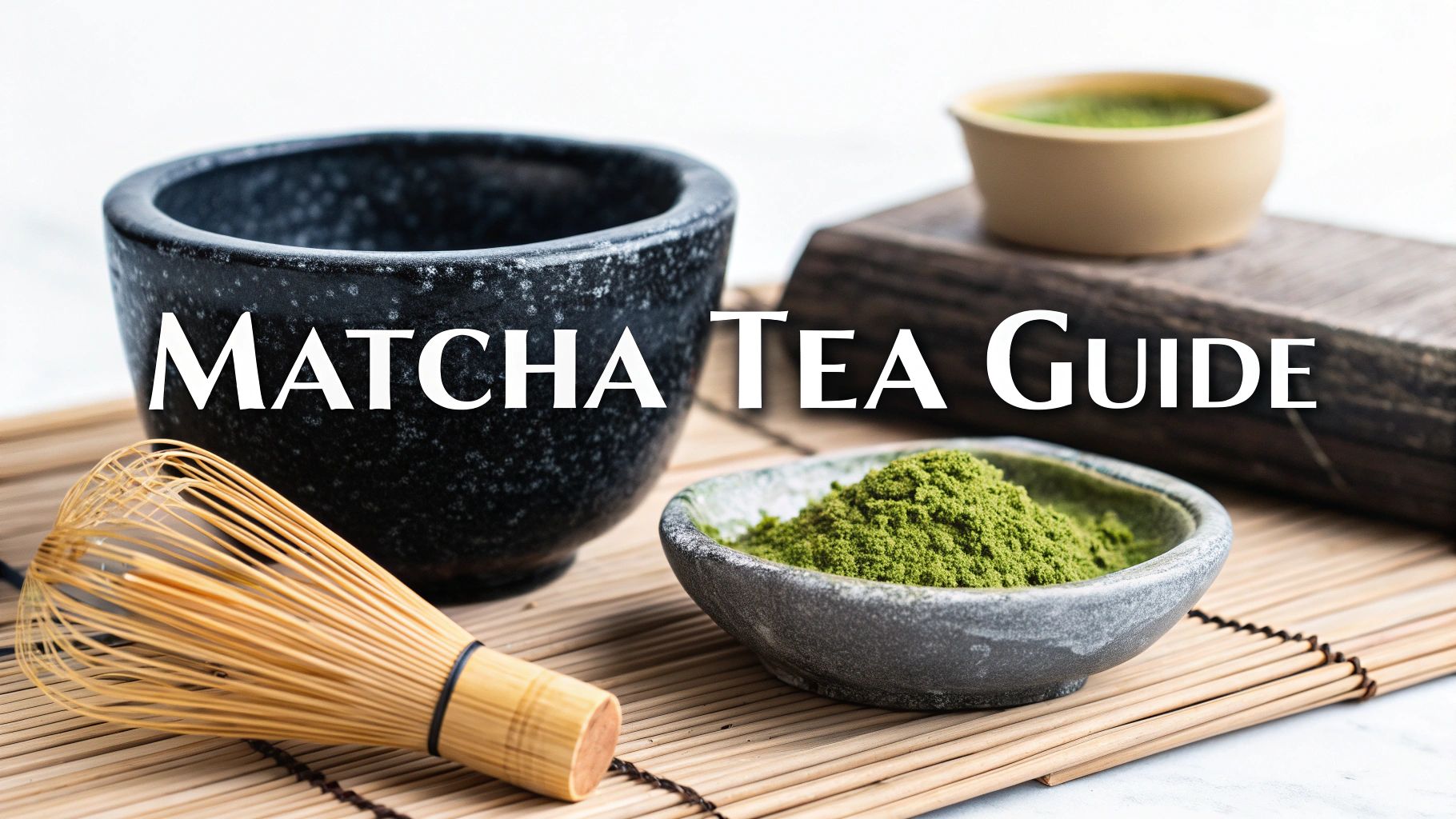Matcha isn't just another green tea. It's a finely milled powder, almost like talc, made from tea leaves that have been carefully grown in the shade. This special process is what gives it that stunning, vibrant green colour and a complex, umami-rich flavour you won't find in any other tea. It's an invitation to pause, reset, and energise your day.
The Essence of Authentic Japanese Matcha
Picture this: you step away from the noise and chaos of your day, taking a moment for pure, focused calm. That's the feeling a bowl of authentic matcha tea from Japan can give you. It’s a world away from your average cuppa; it’s an experience steeped in centuries of tradition, designed to bring harmony to your mind and body.
Unlike regular green tea where you infuse the leaves in hot water and then discard them, with matcha you’re consuming the entire leaf, which has been ground into a silky powder. This is a game-changer. It means you get 100% of the leaf’s nutrients, including a powerful hit of antioxidants and the wonderfully calming amino acid, L-theanine.
A good analogy is the difference between simply boiling an orange peel in water versus eating the whole orange. One gives you a faint echo of the flavour, while the other delivers the full, vibrant taste and all the nutritional benefits. That's why a bowl of matcha feels so much more nourishing and substantial.
Beyond the Brew: A Cultural Icon
The story of matcha started over 800 years ago in the quiet halls of Zen Buddhist monasteries. Monks discovered that drinking it helped them stay alert yet serene during long hours of meditation. Over time, this simple practice blossomed into the beautiful and intricate Japanese tea ceremony, known as Chanoyu, or "the way of the tea."
The ceremony itself is guided by four profound principles:
- Wa (Harmony): Fostering a sense of balance and connection.
- Kei (Respect): Showing deep reverence for the tea, the tools, and each other.
- Sei (Purity): Maintaining both a physical and spiritual cleanliness.
- Jaku (Tranquillity): Reaching a state of inner peace and calm.
These pillars elevate tea drinking from a simple act to a mindful, meaningful ritual. You can explore this rich history further in our deep dive into traditional Japanese matcha.
Today, this ancient tradition has found a new purpose in modern wellness routines all over the world. From trendy Tokyo cafés to quiet kitchens here in the UK, people are realising that matcha offers more than just a caffeine kick—it’s a chance to take a purposeful pause and enjoy clean, sustained energy.
When you choose a premium matcha, you’re doing more than just buying a tea. You’re connecting with a piece of cultural history. Amatsu Matcha pays homage to this legacy by sourcing only the highest quality ceremonial-grade leaves from Uji, Japan. This ensures every sip is an authentic and genuinely enriching experience, making real matcha tea from Japan a special part of any daily routine.
The Art of Transforming Leaf to Powder
The journey of authentic matcha tea from Japan from a tender green leaf into a silky, fine powder is an art form, honed over centuries. This isn't a rushed, industrial process; it's a slow, deliberate craft. Think of a vintner carefully tending their grapes to create a world-class wine—Japanese tea farmers pour that same dedication into producing matcha of exceptional quality.
It all starts in the tea fields, weeks before the first harvest. The Camellia sinensis plants are painstakingly covered with large cloths or traditional bamboo mats. This shading technique, known as kabuse, dramatically reduces the amount of sunlight reaching the leaves. In response, the plants go into overdrive, producing a huge surge of chlorophyll. This is what gives high-grade matcha its iconic, luminous green colour. It also boosts the L-theanine content, the amino acid that creates matcha's unique 'calm alertness' effect.
The Meticulous Harvest and Preparation
When the time is right, only the youngest, most delicate shoots—the tencha—are chosen. These are carefully hand-picked, a selective process that ensures only the best leaves move on to the next stage. This careful selection builds the smooth, sweet, and umami-rich flavour that defines a true ceremonial grade matcha. Anything else just ends up tasting bitter and subpar.
Once picked, the leaves are immediately steamed. It's a quick but vital step that stops oxidation in its tracks, locking in that vibrant colour, the precious nutrients, and the fresh, grassy aroma. Unlike other green teas that get rolled and shaped, the tencha leaves are then gently dried before the painstaking work of de-stemming and de-veining begins. All that's left is the purest part of the leaf.
The entire journey, from shading the leaves to preparing the tencha, is truly a labour of love. It’s this deep respect for tradition that safeguards the quality of the final product, ensuring every bowl of matcha is an experience.
The process is beautifully simple yet requires incredible precision, as you can see below.
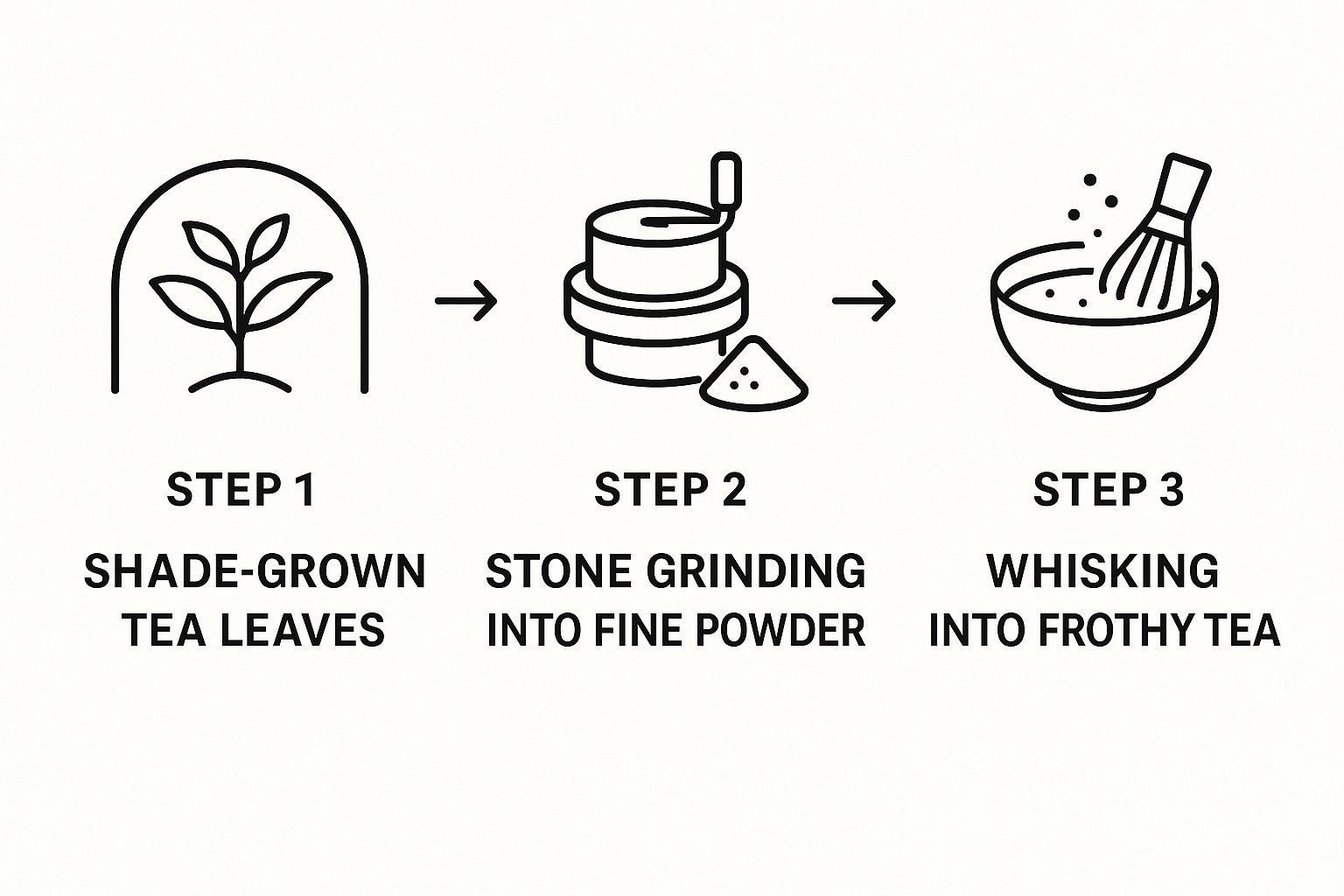
This visual walks you through how the shade-grown leaf is transformed into powder and then whisked into the frothy tea we know and love, capturing the elegance of the method.
The Final Transformation: Stone Grinding
The final, and perhaps most crucial, step is the grinding. Real ceremonial grade matcha is ground slowly between two large, hand-carved granite stone mills. This traditional method generates almost no heat, which is essential for preserving the tea's delicate flavours and nutrients. It’s an incredibly slow process—a single stone mill might take a full hour just to produce 30-40 grams of matcha powder. You can dive deeper into what sets this quality apart in our guide to understanding matcha ceremonial grade.
It’s this painstaking, labour-intensive method that makes authentic matcha a premium product. This dedication to tradition, however, also makes the supply chain quite fragile. For example, extreme weather in Japan's growing regions has impacted crop yields. When you combine that with a surge in global demand, it becomes clear why this precious powder is so sought after. This appreciation for craft and heritage is at the very core of the Amatsu Matcha philosophy; we ensure every tin we produce honours this incredible journey.
How to Choose High-Quality Matcha
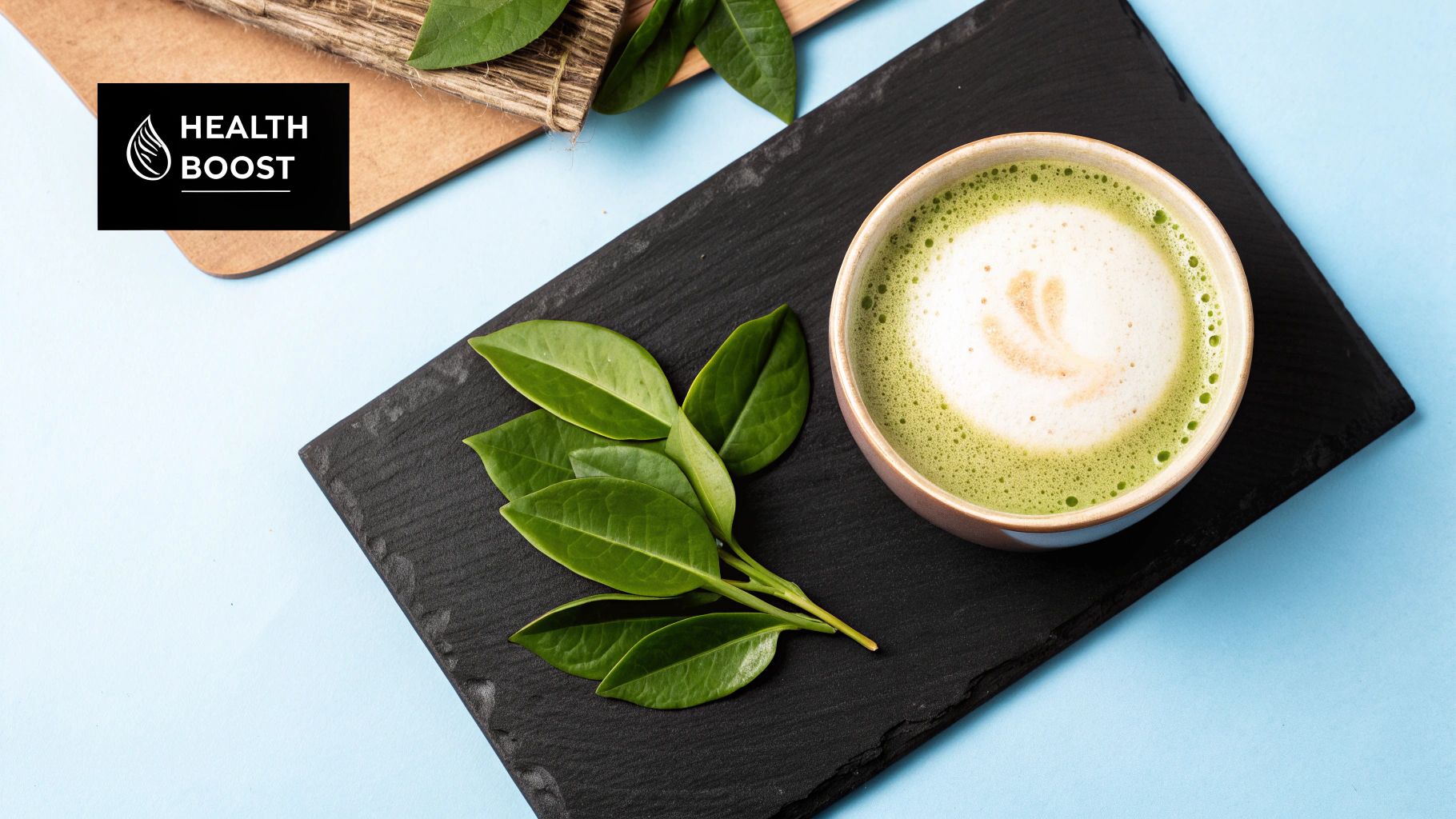
Stepping into the world of matcha can feel daunting, especially when you realise not all green powders are created equal. True, high-quality matcha tea from Japan is a completely different experience from the dull, bitter powders that often sit on shop shelves. But once you know the key signs of quality, you can choose with confidence and make sure every sip is a pleasure.
Think of it like choosing fresh vegetables at a market. You instinctively look for vibrant colours and a fresh scent as clues to quality. The same logic applies to matcha. Your senses are your most reliable tools for finding a premium powder that delivers on both flavour and health benefits.
Fortunately, there are a few clear characteristics that separate the best from the rest. Once you know what to look for, you'll be able to spot exceptional matcha in an instant.
The Tell-Tale Signs of Premium Matcha
The very first thing you'll notice is the colour. High-grade ceremonial matcha should have a brilliant, almost electric, jade green hue. This vivid colour is a direct result of the meticulous shade-growing process, which forces the young tea leaves to produce a huge amount of chlorophyll.
If the powder looks dull, yellowish, or even brownish, it’s a dead giveaway of lower quality. This usually means it was made from older, tougher leaves, harvested later in the season, or has been stored improperly and has oxidised.
Next, pay attention to the texture. A top-tier matcha is stone-ground into an incredibly fine, silky powder, almost like talc or eyeshadow. When you rub a tiny amount between your fingers, it should feel utterly smooth, leaving no gritty feeling behind.
Expert Tip: That fine grind is absolutely crucial for creating a smooth, creamy froth when you whisk it. Coarser powders, often found in culinary grades, just don't dissolve properly and can leave you with a clumpy, unpleasant bowl of tea.
This delicate texture is achieved through slow, traditional stone milling—a painstaking method that protects the fragile nutrients and flavour compounds from heat damage.
Flavour Profile and Aroma
The smell of a superior matcha is another huge clue. When you open a tin of ceremonial-grade matcha, you should be greeted by a fresh, sweet, and slightly grassy fragrance with savoury undertones. This complex bouquet is a delicious promise of the rich flavour to come.
By contrast, lower-quality matcha often has a flat, dusty, or hay-like smell, which tells you it’s not fresh and probably won't taste very good. A truly premium matcha’s flavour is smooth and complex, with a signature umami (savoury) depth that’s perfectly balanced by a subtle, natural sweetness. It should leave a pleasant, lingering finish with absolutely no bitterness.
If your matcha tastes overwhelmingly bitter or astringent, it’s a sure sign that it is not ceremonial quality. This bitterness often comes from using mature, sun-grown leaves that lack the high concentrations of L-theanine found in the special shade-grown tencha. To dive deeper, check out our complete guide on finding the best quality matcha.
Ceremonial vs Culinary Grade A Quick Comparison
To make the right choice, it really helps to understand the fundamental differences between the two main grades of matcha. Simply put, Ceremonial grade is designed for drinking on its own with water, while culinary grade is meant to be used as an ingredient in lattes, smoothies, and baking.
The table below breaks down the key distinctions to look out for.
| Attribute | Ceremonial Grade Matcha | Culinary Grade Matcha |
|---|---|---|
| Colour | Vibrant, deep jade green | Dull, yellowish-green or brown |
| Texture | Ultra-fine, silky powder | Coarser, slightly gritty powder |
| Flavour | Smooth, rich umami, naturally sweet | Strong, bitter, astringent flavour |
| Aroma | Fresh, sweet, vegetal scent | Flat, dusty, or hay-like smell |
| Origin | Youngest leaves from the first harvest | Leaves from later harvests |
| Best For | Drinking traditionally with hot water | Cooking, baking, and lattes |
By keeping these points in mind, you can confidently choose an exceptional product. A matcha like Amatsu Matcha Pure is sourced exclusively from first-harvest, ceremonial-grade leaves, ensuring you get that authentic, superior experience every single time.
The Science Behind Matcha's Health Benefits
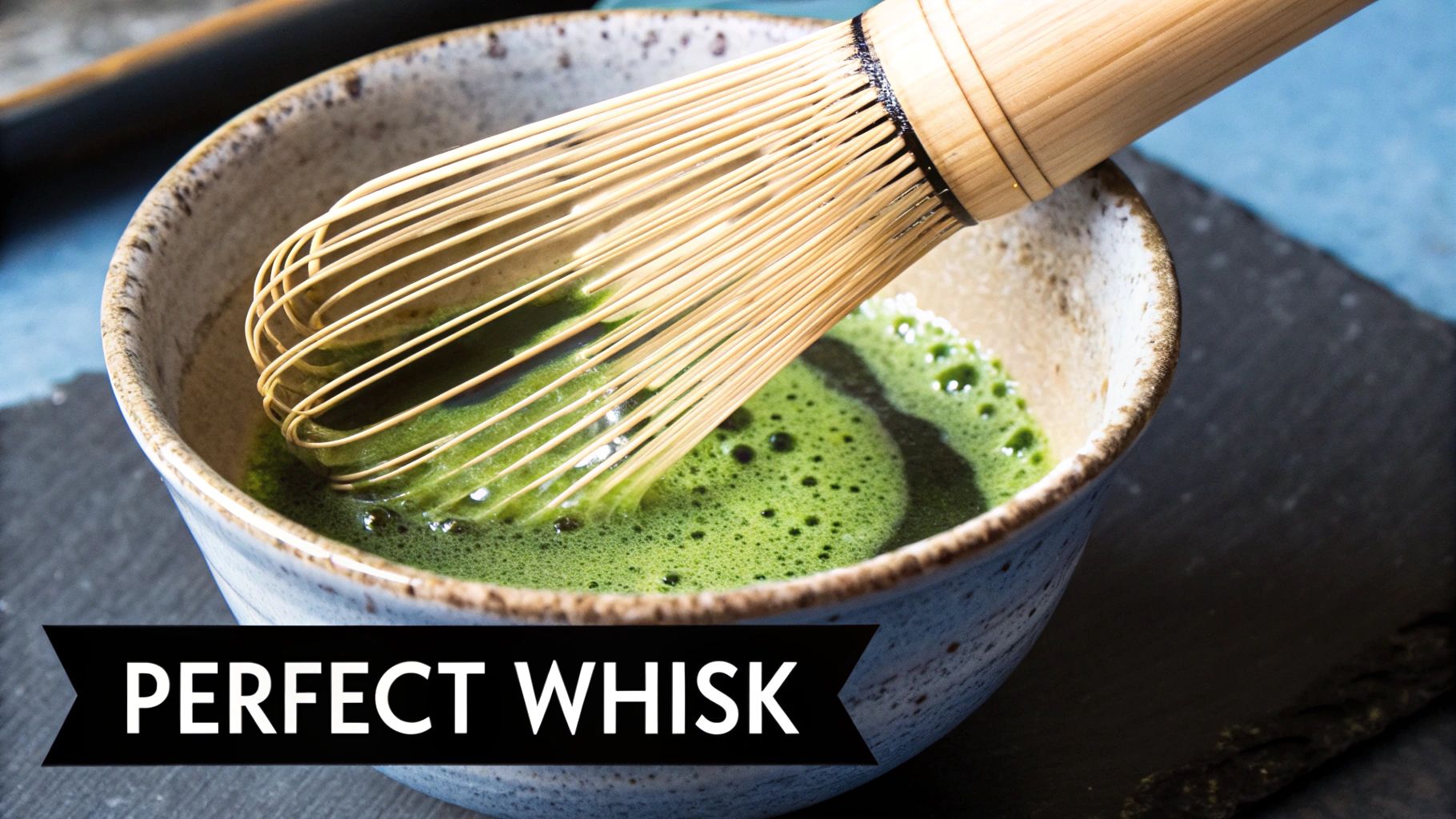
While the striking green colour and deep, umami flavour of matcha tea from Japan are what first draw people in, its reputation as a wellness powerhouse is built on solid science. The secret is simple. Unlike regular green tea where you steep the leaves and throw them away, with matcha you consume the entire, powdered leaf.
This small but crucial difference means you’re ingesting a concentrated dose of incredible compounds that support both your mind and body, rather than just the water-soluble elements that infuse into a typical brew.
At the heart of matcha's goodness are powerful antioxidants known as catechins. Matcha is particularly packed with a specific one called epigallocatechin gallate, or EGCG. Think of EGCG as your body's personal bodyguard, fighting off free radicals that cause oxidative stress and inflammation—two key culprits behind chronic health issues and the ageing process.
Because you’re drinking the whole leaf, you get a staggering amount of these antioxidants. Some studies have found that matcha can contain up to 137 times more EGCG than other types of green tea. It’s genuinely one of the most potent antioxidant sources on the planet.
The Phenomenon of Calm Alertness
One of the most cherished effects of matcha is the state of ‘calm alertness’ it delivers. If coffee often leaves you with jitters and a harsh energy crash a few hours later, matcha offers a much smoother, more sustained ride. This unique quality comes from the perfect partnership between its caffeine and a rare amino acid, L-theanine.
L-theanine is brilliant at promoting a feeling of relaxation without making you feel sleepy. It does this by boosting alpha waves in your brain—the same ones that are active when you're in a state of relaxed focus, like during meditation.
This natural pairing of L-theanine and caffeine is matcha's secret weapon. The L-theanine beautifully tempers the stimulating effects of the caffeine, giving you hours of clean, focused energy without the anxious buzz or dreaded slump from coffee.
This makes matcha the perfect companion for work, study, or any time you need to stay sharp and concentrated while still feeling grounded and calm.
Boosting Metabolism and Cognitive Function
The benefits don't stop there. The same potent EGCG that fights off free radicals has also been shown to have a thermogenic effect. In simple terms, it can help gently boost your metabolism, increasing the rate at which your body burns calories. Making matcha a part of a balanced lifestyle is a fantastic way to support your overall wellness goals.
Beyond the body, the compounds in matcha are true allies for your brain. Regular consumption has been linked to noticeable improvements in several cognitive areas.
- Enhanced Memory: Research suggests matcha's components can help with both short-term recall and long-term memory.
- Improved Attention: That signature calm alertness makes it easier to lock in on tasks for longer stretches.
- Faster Reaction Times: The unique blend of caffeine and L-theanine can also sharpen cognitive processing and speed up your reaction times.
For a closer look at its makeup, you can dive into our detailed guide on what is in matcha powder. Understanding these foundational elements helps to appreciate how our specialised blends are crafted. For instance, Amatsu Matcha Shrooms is designed specifically to elevate focus, while the Strength blend is engineered to support physical performance, each building on the natural scientific advantages that matcha already provides.
A Modern Guide to Preparing Matcha
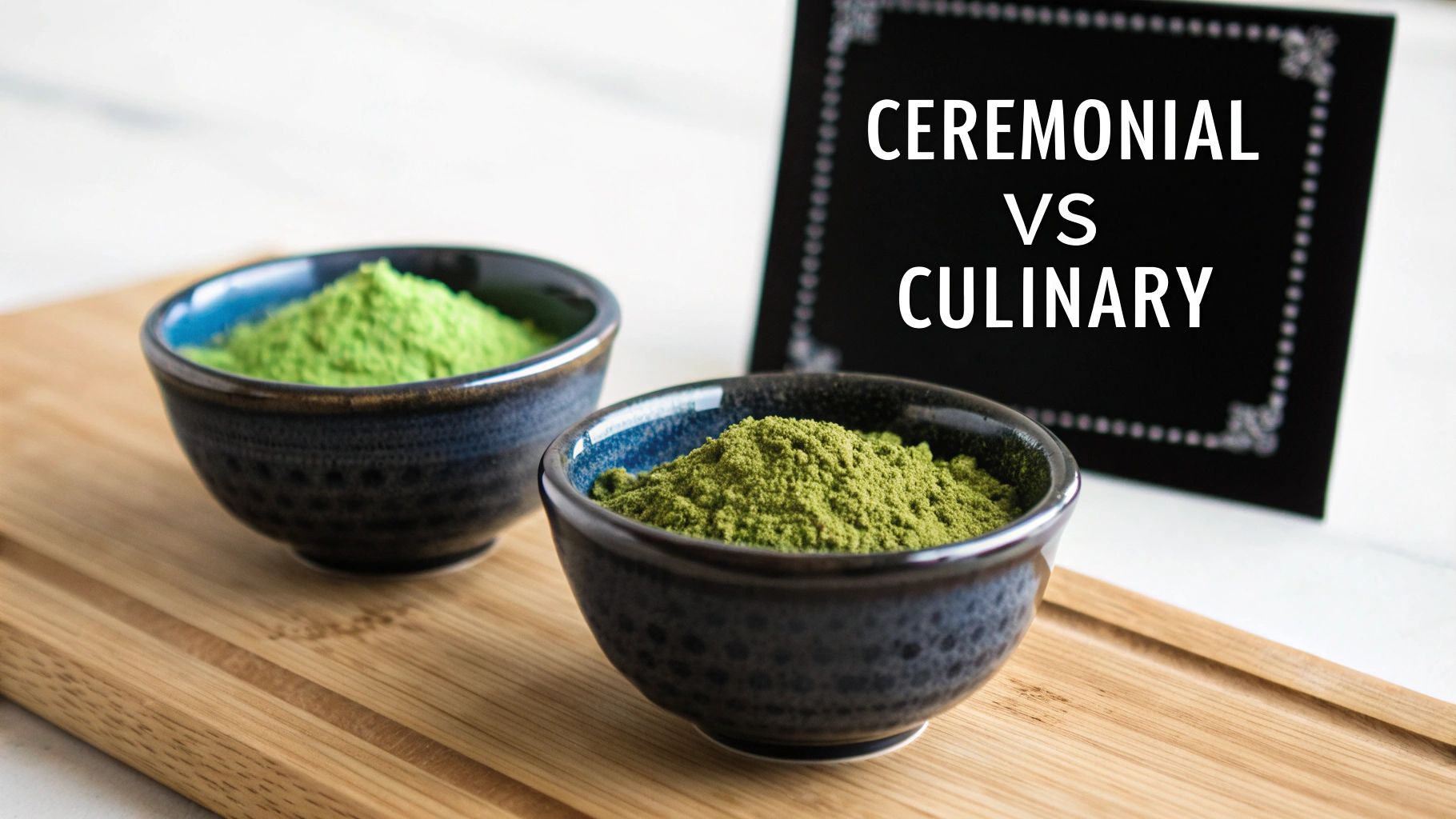
Making a bowl of authentic matcha tea from Japan is about so much more than just mixing powder and water. It's a chance to build a small, mindful ritual into your day—a quiet moment of focus and calm. While a traditional Japanese tea ceremony is a beautiful and complex art, you can easily borrow its core principles to craft the perfect bowl right in your own kitchen.
This guide will walk you through the essential steps, turning what might seem like a tricky process into a genuinely enjoyable practice. With the right kit and a little know-how, you’ll be whisking up a flawless, frothy matcha that truly honours its rich heritage. It’s a rewarding process that makes the first sip all the more satisfying.
Gathering Your Essential Tools
To get started, you really only need a few key items. Try to think of them less as utensils and more as partners in your matcha ritual. Each piece has a specific role, designed to bring out the very best in your high-quality matcha.
- The Chawan (Tea Bowl): A wide, flat-bottomed bowl is what you’re looking for. Its shape gives you plenty of room to whisk properly and build up that signature creamy froth.
- The Chasen (Bamboo Whisk): For real matcha, this is non-negotiable. A chasen is typically carved from a single piece of bamboo, and its dozens of delicate prongs are engineered to aerate the tea and dissolve the powder completely.
- The Chashaku (Bamboo Scoop): This is simply a slender bamboo scoop used to measure out the perfect amount of matcha. One to two scoops is usually all you need for a single serving.
- A Fine-Mesh Sifter: Don’t skip this one! This small but vital tool is your secret weapon against clumps, guaranteeing a silky-smooth texture every time.
Having these tools on hand really elevates the whole experience, turning it from just making a drink into a proper mindful practice.
The Step-By-Step Preparation Ritual
Once you have your tools ready, the process itself is wonderfully simple and almost meditative. Follow these steps to prepare a perfect bowl of Amatsu Matcha.
1. Sift Your Matcha Powder
First things first, use your chashaku to measure one to two scoops (that’s about 1-2 grams) of matcha into your sifter. Hold it over your chawan and gently tap the side until all the fine powder falls into the bowl. This is a crucial step for breaking up any little clumps and getting that smooth, velvety consistency.
2. Add Warm Water
Next, it’s time for the water. You’ll want to heat it to around 80°C (175°F)—but never boiling. If the water is too hot, it will scorch the delicate tea leaves and leave you with a bitter taste. Pour about 60-70ml (2-3 ounces) of the warm water over your sifted matcha.
A Quick Tip: Don’t have a temperature-controlled kettle? No problem. Just bring your water to a full boil, then let it sit and cool for a few minutes before you pour. This simple trick does wonders for protecting the matcha’s delicate flavour.
3. Whisk to Perfection
Here comes the most important part. Hold the chawan steady with one hand and take your chasen in the other. Start whisking the matcha and water mixture vigorously in a quick 'W' or 'M' shaped pattern. The key is to keep your wrist loose and focus on a rapid back-and-forth motion, not stirring in circles.
Keep this up for about 20-30 seconds. You’re aiming for a thick, frothy layer of tiny bubbles to form on the surface, a bit like the crema on a good espresso. This froth is the hallmark of a beautifully prepared bowl of matcha tea from Japan.
4. Savour the Moment
Once you have that lovely froth, your matcha is ready. Before you take a sip, pause for a moment to appreciate the vibrant green colour and the fresh, grassy aroma. Drinking it directly from the bowl, after this mindful pause, is all part of the experience.
This daily ritual is quickly catching on here in the UK, where the appetite for high-quality matcha is booming. Forecasts actually predict the UK matcha market will grow at a compound annual rate of 8.3% from 2025 to 2030. It’s a huge trend, with powdered matcha alone making up over 55% of sales in 2024, as people discover its versatility and health benefits. You can read more about this in a recent market analysis.
By starting with a premium product like Amatsu Matcha, you can be sure your home ritual is truly exceptional from the very first sip.
Finding Your Perfect Amatsu Matcha
Now that you've got a feel for the incredible craft behind authentic Japanese matcha, let's find the blend that’s just right for you and your wellness goals. Everyone's needs are different, which is exactly why we created a focused collection to support different aspects of your life. Whether you're after traditional purity or a functional boost, we have a blend designed for you.
Think of our range as a toolkit for modern life. Every blend starts with the same exceptional ceremonial-grade matcha from Uji, Japan, but each is then enhanced with specific, high-quality ingredients to help you hit your target. Here’s a quick guide to help you find your perfect match(a).
For the Purist: Amatsu Matcha Pure
If you're a traditionalist at heart and want to experience matcha in its truest, most authentic form, then Amatsu Matcha Pure is your perfect choice. This is our foundational blend—nothing added, nothing taken away. Just pure, unadulterated, first-harvest ceremonial grade matcha.
It’s perfect for anyone who appreciates the ritual of a traditional Japanese tea ceremony, or simply wants to enjoy the smooth, rich umami flavour and clean energy lift that only the finest matcha can deliver. This blend is your direct connection to centuries of Japanese heritage.
For a Youthful Glow: Amatsu Matcha Radiance
For those who believe beauty truly starts from the inside out, our Amatsu Matcha Radiance is designed to help you glow. We’ve combined our premium matcha with marine collagen, a powerhouse protein known for supporting skin elasticity and hydration.
Making this a part of your daily routine means you're not just getting the antioxidants from the matcha; you're also actively nourishing your body to promote a vibrant, youthful complexion. You can dive deeper into the amazing synergy of these ingredients in our article on the benefits of collagen matcha for your skin.
Choosing a premium blend is an investment in your wellbeing. As global demand for high-quality matcha soars, so does its value. In major markets like the US, sales of powdered matcha have surged by 86% in the last three years, causing prices to increase significantly. As the UK market follows this trend, securing a trusted source for authentic matcha becomes even more important. You can find more details about these market dynamics and why matcha prices are on the rise.
For Sharp Focus: Amatsu Matcha Shrooms
If mental clarity and staying sharp are at the top of your list, then Amatsu Matcha Shrooms is your secret weapon. We’ve boosted our ceremonial matcha with a potent mix of adaptogenic mushrooms, including Lion's Mane and Cordyceps.
This powerful combination is specifically designed to support cognitive function, enhance concentration, and help you sail through a demanding day with a sense of calm, sustained focus. It’s the perfect upgrade for busy professionals, students, or anyone who needs that extra mental edge.
For Peak Performance: Amatsu Matcha Strength
Finally, for anyone leading an active lifestyle, Amatsu Matcha Strength is formulated to support your physical performance and recovery. This unique blend is enriched with creatine, a well-researched compound famous for boosting energy production and muscle strength.
It makes for an ideal pre- or post-workout drink, combining the natural energy of matcha with the proven benefits of creatine to help you smash your fitness goals. By choosing the right blend, you can turn your daily cup of tea into a powerful ritual that truly works for you.
Your Matcha Questions Answered
Diving into the world of authentic matcha tea from Japan often sparks a bit of curiosity. To clear things up and get you started on the right foot, we’ve put together some answers to the questions we hear most often.
How Much Caffeine Is in Matcha Compared to Coffee?
You might be surprised. A standard serving of matcha has about 70mg of caffeine, which is a little less than the average cup of coffee at around 95mg. But that's where the comparison ends.
The real magic of matcha is how it delivers that energy. Thanks to an amino acid called L-theanine, the caffeine is released slowly and steadily. This gives you a feeling of calm, alert focus—all of the energy, but none of the jitters or the dreaded afternoon crash that coffee can bring.
Is It Okay to Drink Matcha Every Day?
Absolutely. For most people, a cup or two of matcha each day is a brilliant way to boost your well-being. It’s packed with an incredible amount of antioxidants, making it a powerful part of any healthy routine.
Of course, like anything with caffeine, it’s wise to listen to your body. Pay attention to how you feel and find the balance that works for you.
We're often asked why ceremonial grade matcha costs more. The price comes down to the sheer artistry and effort involved. It's made using only the youngest, most tender leaves from the year's first harvest, which are shade-grown for weeks and then slowly stone-ground. This painstaking process is what gives it that incredibly smooth flavour and vibrant green colour.
What Is the Best Way to Store Matcha?
Freshness is everything when it comes to matcha. Its delicate flavour, colour, and nutrients are vulnerable to light, air, and heat.
To keep it at its best, store your matcha in an airtight, opaque container somewhere cool and dark. The refrigerator is the perfect place, especially once you've opened the tin, as it helps preserve its peak quality for longer.
Ready to start your own mindful matcha ritual? Take a look at the premium ceremonial blends from Amatsu Matcha and find the perfect partner for your wellness journey. Discover our collection today.
Read more
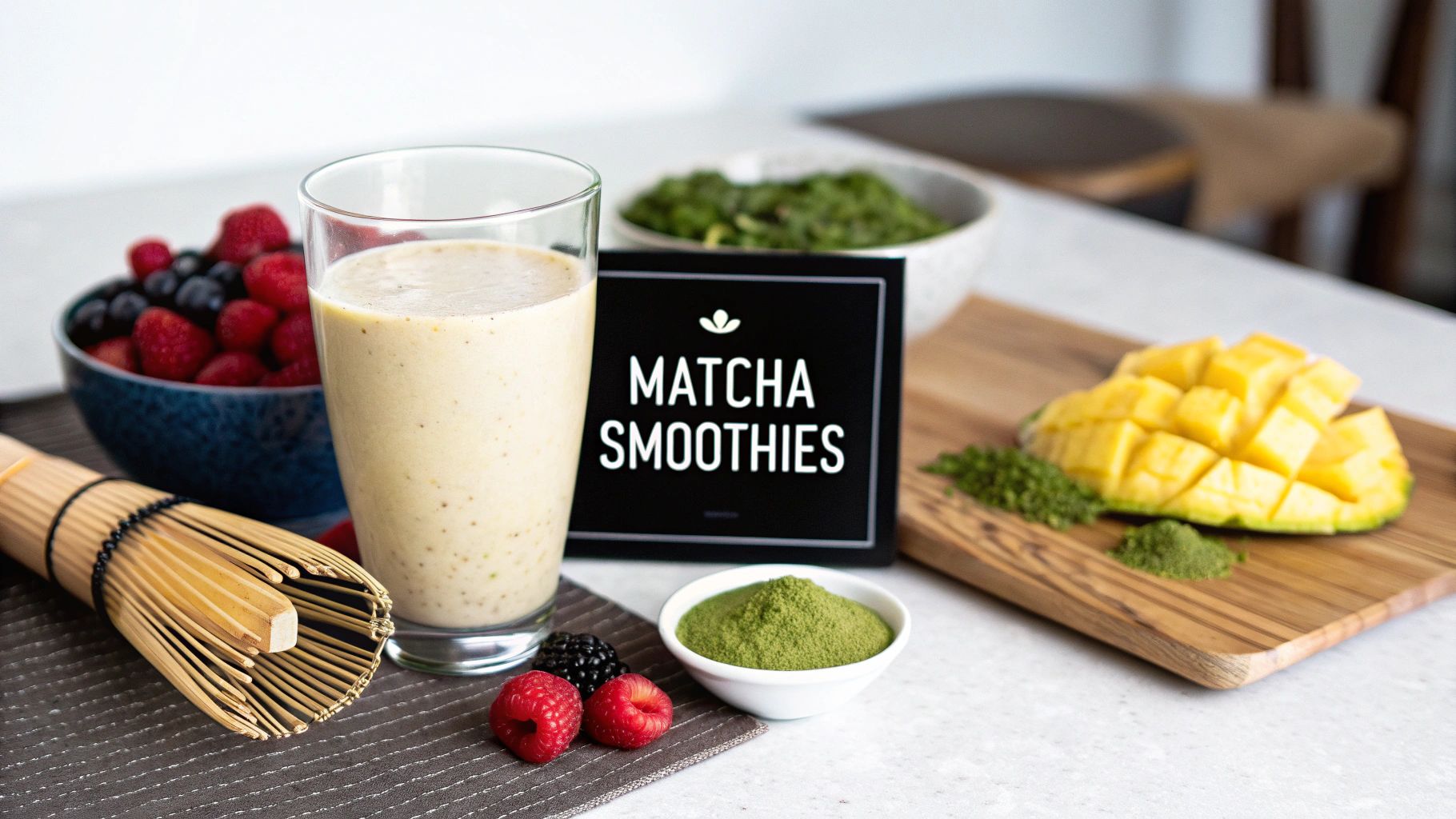
Discover 4 energizing matcha recipes smoothie lovers will adore. Boost your wellness with delicious, easy-to-follow guides using premium Amatsu Matcha.
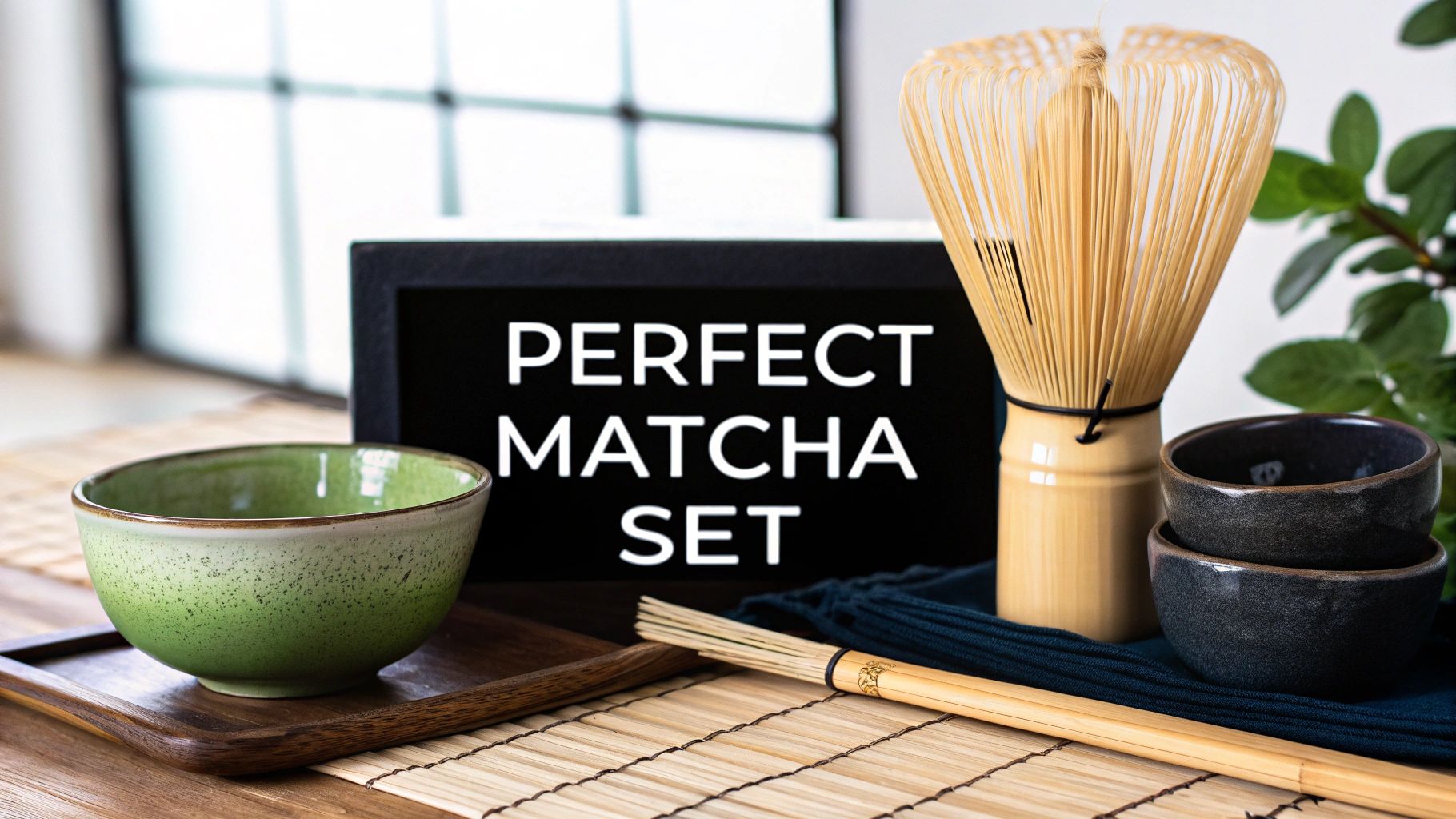
Discover how to choose, use, and care for a ceremonial matcha set. Elevate your daily ritual with our expert guide to authentic Japanese tea.
